This is an old revision of the document!
The Codices
Book/Tome, Artifact, Requires Attunement
History
A codex grants its owner remarkable powers beyond the scope of even most artifacts. Many were created around when the world entered the magic era, some of them even binding certain magics and abilities to the world, if they were to be removed or destroyed they could cause instability and devastation.
The codices are spread far and wide across the world. Often guarded by powerful indivduals, giant monstrosities, or by a nation's armies. They could also be lost under rubble or in an old library forgotten to time.
Attuning
All the codices require attunement, which requires the reader to spend a month in uninterrupted study of no less than 8 hours per day, 6 days per week.
Once attuned, the owner of the codex need not take the book with them. They can leave it in a secure location and still gain its benefits, but must refresh their knowledge through 8 hours of uninterrupted study once per month or else lose its benefits.
Sacrifice
Some of these books require the attuned owner to surrender some of their life essence to satiate the dark powers constrained or described in their texts.
Sacrificing requires rolling some number of Hit Dice, losing that many hit points and the Hit Dice immediately, and reducing your maximum hit points by the same amount. While the effect powered by the sacrifice persists, the lost hit points and Hit Dice cannot be regenerated. When the effect ends, you can heal the damage and recover the Hit Dice normally.
If sacrificing Hit Dice causes you to drop to 0 hit points, you fall unconscious and all effects you created end. You cannot sacrifice more Hit Dice than you have. If you must sacrifice a Hit Die to power an effect but you have none, the effect ends.
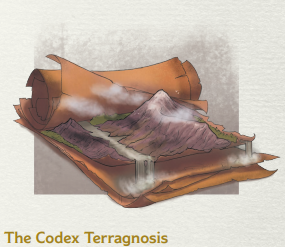
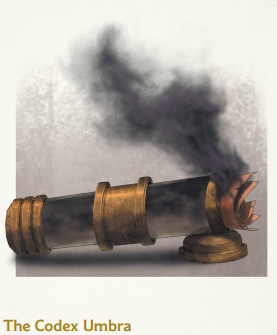
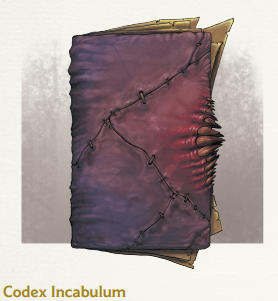
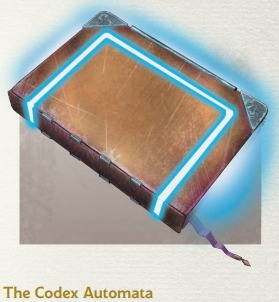
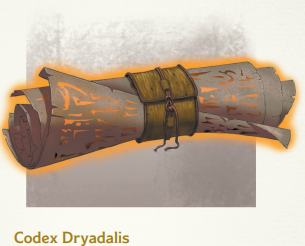
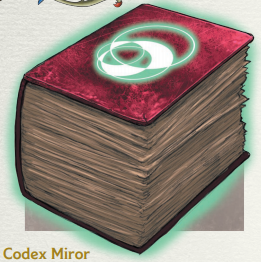
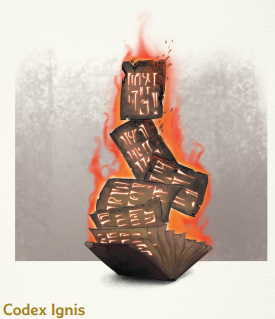
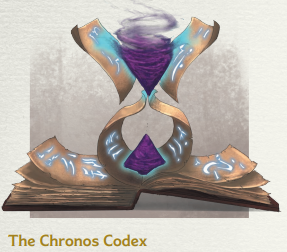
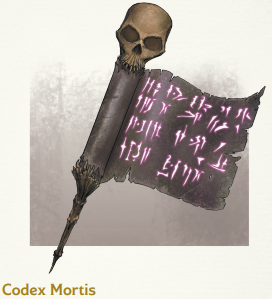
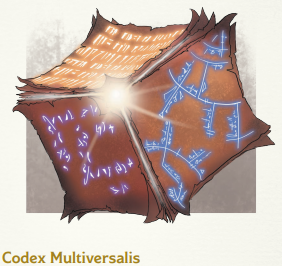
Note descriptions still need to be updated to Nightcall lore, below is Strongholds & Followers lore
The Codex Terragnosis
Written by Hierophant Prithviraña in the 738th year of the Age of Wonders, this book is a comprehensive treatise on the nature of the Mundane World and the material and philosophical principles that set it apart from Arcadia, Quintessence, and the World Below.
This codex illuminates the Law of Nature, the Law of Time, and the Law of Death and contains a description of the world’s creation, the origins of divine and arcane magic, as well as the War Between the Gods.
The Hierophant built his wisdom and knowledge into the codex terragnosis. The book binds and shapes the world, defines it and defends it. While it resides within this manifold of the timescape, the Mundane World is safe.
The Codex Umbra
Kalidasa Dhar, writing in the codex umbra in the second century of Wonder, gives us our only glimpse into scholarly thought regarding the essence of shadow magic before the Ganarajyan Empire. It is surprisingly similar to our own modern notions.
Dhar hypothesized that the dark power we call shadow is the dead life essence of a previous world. What the nature of this world or the beings that may have inhabited it was, she offers no insight. Few modern sages take Dhar’s theory seriously, but all note that no wizard since has penetrated the heart of shadow so successfully.
Whoever holds the codex umbra and understands its secrets gains access to the following abilities.
Codex Incabulum
The only codex known to be written during the Caelian Empire, the codex incabulum is often incorrectly cited as the cause of the Fall of Azshan. This is a popular guess repeated so often that it has attained the status of fact. Rather, the codex stopped the demonic infestation that razed the ruling city of Kham, confining the
sea of fiends that erupted from hell and preventing it from spreading across the world. As a result, no contemporaneous accounts of the sack of the city survive, with the popular histories of the event being authored no earlier than 150 years after the event.
Authored by Marcus Gaius Orestes18 in the 101st year of the Age of Conquest, during the height of the Caelian Empire, this book—like all the codices—has been lost and found many times over the centuries since. Often those who attune to it delve deep into dark powers and are lost.
The Codex Automata
Written by the Hànz wizard Huang Fei late in the third dynasty of the Xin Empire, the codex automata—The Book of Machines—synthesized three thousand years of scholarly thought on the subject of magical constructs and was instantly realized as the definitive work on the subject. Other tomes detail the process of creating a golem, but Fei called this “mere smithery.”
Fei’s goal was to understand the fundamental magic of animated constructs, and in this he succeeded beyond his wildest dreams. His golem army defended the emperor and secured his dynasty’s rule for a thousand years.
Codex Dryadalis
A human adopted as an infant by elves, Irllyn Ffwllyg en Orrell ce Yth went on to become the Ganarajyan Empire’s greatest authority on the fae, their magic, and their casual association with cause and effect.
Because she was a mortal wizard, she understood the rules that constrained the use of magic. Because she was raised as an elf, she had the mind of a fae. Because she was the greatest wizard of her time, she was able to synthesize these two antithetical philosophies into one coherent masterwork and thereby change the world forever. The elves never allowed this again.
Codex Miror
Written by Durthara, the Empress’s Archmage, the Book of Wonder is the first recorded codex and gave the Age of Wonder its name. In those days, the Ganarajyan Empire’s word for “magic” translated as “wonder” or “marvel.” Magic, then, was newly discovered by Men and seemed a limitless resource. Spells were invented, made fashionable, and forgotten before anyone knew they could be written down.
History records the codex miror as the greatest, the most powerful of the codices, but no sage has ever owned more than two, so no one in history could claim to be an expert, and most of the records of what the Book of Wonder could do were written hundreds of years after it disappeared.
Codex Ignis
Hu Tai was the last Magister of Fire, and like her contemporaries, the other four elemental magisters, she swore to bind her knowledge into a tome and thereby seal it away, ending the Century of Five Emperors and the wars that ensued as each emperor’s elemental magister used their lore to warp and twist reality for their regent.
History records that her efforts were successful. The Five Magisters sealed their power away, and the wars ended. Only rarely in the thousands of years since has one of the five elemental codices emerged and been mastered, and never more than one has been active in the world since.
The Chronos Codex
Like the codex multiversalis, the origins of the chronos codex are not well recorded. Its earliest reference is in the possession of the Ganarajyan wizard Subhadrangi, who may also be the book’s author. The book is also referenced in the Tales of Rupananda, but it’s possible Subhadrangi and Rupananda were the same woman. A handful of references talk of a sage who went by both names during that age, but there’s no direct confirmation from any contemporary source, and no source definitively claims either woman wrote it or indeed gives an independent account of the life of either.
The Book of Time is the least well known of the codices. It tends to disappear for millennia at a time, and as a result, unlike the other Books of Magic, scholars are happy to leave it drifting in the eddies of the time stream.
It was only 300 years ago when the Khoursir scholar Chartam suggested that the book’s author had not yet been born, and that the book’s presence in the past of this time manifold is a result of its future author using its power. This once-fringe hypothesis has grown in popularity in recent years.
Codex Mortis
Exiled Empress Wu Jiao wasted no time planning her return to the throne and the restoration of the Wu dynasty. Her first goal was the return of her greatest general, the barbarian Lady Czorgan. As Czorgan was dead, this meant much research was in order. But Empress Jiao was already an accomplished wizard, and her first success took less than a year.
Emboldened by her necromantic research and the return of her right hand, Jiao pressed her study further and became the greatest necromancer in history. She succeeded in restoring her family to the throne, but history calls her the Dead Empress and her second period of rule the Dead Empire, granting her no narrative of restoration, only revenge.
Attuning to this dread book requires sacrificing 2 Hit Dice.
Codex Multiversalis
Certainly the first wizard to enter history as an owner of the Book of All Worlds was Padmavati, the Alienist. But there’s no actual record of her writing it, though scholarly consensus is that only she could have done so. Instead, the accepted wisdom is that she did write it, just not in this manifold. She is from a different world, sages presume. The truth may never be known. The deeds she performed are well-documented, including enacting The Forbidding, which permanently exiled the Demon Lord of Death to the Seven Cities of Hell. If the nature of this ritual is detailed in the codex multiversalis, no wizard since has deciphered it.
Attuning to the Book of All Worlds exposes you to the energies of a million worlds. This turns your eyes solid black. It does not damage your sight, but you are marked for as long as you stay attuned to the book.